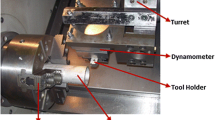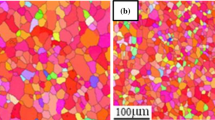Abstract
A multivariable empirical model based on an artificial neural network (ANN) was developed in order to predict the vertical force occurring during friction stir welding (FSW) of sheets in AZ31 magnesium alloy. To this purpose, FSW experiments were performed at different values of rotational and welding speeds, and the vertical force versus time curve was recorded during the different stages of the process by means of a dedicated sandwich dynamometer. Such results were used in the training stage of the artificial neural network-based model developed to predict vertical force versus time curves. A multi-layer feed forward ANN, using the back-propagation algorithm, consisting of the input layer with four input parameters (rotational speed, welding speed, rotational speed to welding speed ratio and processing time), two hidden layers with four neurons each, and the output layer with the vertical force as output, was built and trained. The generalization capability of the ANN was tested using a two-step procedure: in the former, the leave-one-out cross-validation method was used whilst, in the latter, curves not included in the training dataset were taken into account. The low values of the relative error and average absolute relative error, and the high correlation coefficients between predicted and experimental results have proven the excellent capability of the artificial neural network in modeling complex shape of the curve and in capturing the effect of the process parameters on the vertical force without a priori knowledge of the complex microstructural and mechanical mechanisms taking place during friction stir welding. Finally, the relationship between vertical force and processing time, at different welding and rotational speeds, was also predicted using the support vector machine algorithm and the results were compared with those given by the ANN-based model.













Similar content being viewed by others
References
Mishra RS, Ma ZY (2005) Friction stir welding and processing. Mater Sci Eng R 50:1–78
Nandan R, DebRoy T, Bhadeshia HKDH (2008) Recent advances in friction-stir welding—process, weldment structure and properties. Prog Mater Sci 53:980–1023
Cabibbo M, Forcellese A, Simoncini M (2016) New approaches to the friction stir welding of aluminum alloys. In: Ishak M (ed) Joining technologies. InTech, Osaka, pp 7–26
Stasik MC, Wagoner RH (1996) Forming of tailor welded aluminum blanks. Aluminum and magnesium for automotive applications. The Minerals, Metals & Materials Society, Pittsburgh, pp 69–83
Contuzzi N, Campanelli SL, Casalino G, Ludovico AD (2016) On the role of the thermal contact conductance during the friction stir welding of an AA5754-H111 butt joint. Appl Therm Eng 104:263–273
Buffa G, Hua J, Shivpuri R, Fratini L (2006) Design of the friction stir welding tool using the continuum based FEM model. Mater Sci Eng A 419:381–388
Reza-E-Rabby MD, Reynolds AP (2014) Effect of tool pin thread forms on friction stir weldability of different aluminum alloys. Procedia Eng 90:637–642
Bevilacqua M, Ciarapica FE, D’Orazio A, Forcellese A, Simoncini M (2016) Sustainability analysis of friction stir welding of AA5754 sheets. Procedia CIRP. https://doi.org/10.1016/j.procir.2016.06.081
Forcellese A, Martarelli M, Pandarese G, Simoncini M (2013) Similar and dissimilar FSWed joints in lightweight alloys: heating distribution assessment and IR thermography monitoring for on-line quality control. Key Eng Mater 554–557:1055–1064
Lakshminarayanan AK, Balasubramanian V, Elangovan K (2009) Effect of welding processes on tensile properties of AA6061 aluminum alloy joints. Int J Adv Manuf Technol 40:286–296
Shrivastava A, Krones M, Pfefferkorn FE (2015) Comparison of energy consumption and environmental impact of friction stir welding and gas metal arc welding for aluminum. CIRP J Manuf Sci Technol 9:159–168
Casalino G, Campanelli S, Mortello M (2014) Influence of shoulder geometry and coating of the tool on the friction stir welding of aluminium alloy plates. Procedia Eng 69:1541–1548
Upadhyay P, Reynolds AP (2012) Effects of forge axis force and backing plate thermal diffusivity on FSW of AA6056. Mater Sci Eng A 558:394–402
Benyounis KY, Olabi AG (2008) Optimization of different welding processes using statistical and numerical approaches—a reference guide. Adv Eng Softw 39:483–496
Buffa G, Fratini L, Simoncini M, Forcellese A (2016) In-process tool force and rotation variation to control sheet thickness change in friction stir welding of magnesium alloys. In: AIP conference proceedings 1769: article number 100008. https://doi.org/10.1063/1.4963502
Buffa G, Campanella D, Forcellese A, Fratini L, La Commare U, Simoncini M (2018) In-process control strategies for friction stir welding of AZ31 sheets with non-uniform thickness. Int J Adv Manuf Technol 95(1–4):493–504
He X, Gu F, Ball A (2014) A review of numerical analysis of friction stir welding. Prog Mater Sci 65:1–66
Forcellese A, Martarelli M, Simoncini M (2016) Effect of process parameters on vertical forces and temperatures developed during friction stir welding of magnesium alloys. Int J Adv Manuf Technol 85:595–604
Astarita A, Squillace A, Carrino L (2014) Experimental study of the forces acting on the tool in the friction-stir welding of AA 2024 T3 sheets. J Mater Eng Perform 23(10):3754–3761
Trimble D, Monaghan J, O’Donnell GE (2012) Force generation during friction stir welding of AA2024-T3. CIRP Ann Manuf Technol 61:9–12
Buffa G, Fratini L, Hua J, Shivpuri R (2006) Friction stir welding of tailored blanks: investigation on process feasibility. CIRP Ann Manuf Technol 55(1):279–282
Bariani PF, Dal Negro T, Bruschi S (2004) Testing and modelling of materials response to deformation. CIRP Ann Manuf Technol 53(2):1–22
Zhu Y, Zeng W, Sun Y, Feng F, Zhou Y (2011) Artificial neural network approach to predict the flow stress in the isothermal compression of as-cast TC21 titanium alloy. Comput Mater Sci 50:1785–1790
Mandal S, Sivaprasad PV, Venugopal S, Murthy KPN (2009) Artificial neural network modeling to evaluate and predict the deformation behavior of stainless steel type AISI 304L during hot torsion. Appl Soft Comput 9:237–244
Bruni C, Forcellese A, Gabrielli F, Simoncini M (2006) Modelling of the rheological behaviour of aluminium alloys in multistep hot deformation using the multiple regression analysis and artificial neural network techniques. J Mater Process Technol 177:323–326
Forcellese A, Gabrielli F, Simoncini M (2011) Prediction of flow curves and forming limit curves of Mg alloy thin sheets using ANN-based models. Comput Mater Sci 50:3184–3197
Ambrogio G, Gagliardi F (2013) Design of an optimized procedure to predict opposite performances in porthole die extrusion. Neural Comput Appl 23:195–206
Vundavilli PR, Phani Kumar J, Sai Priyatham Ch, Parappagoudar MB (2015) Neural network-based expert system for modeling of tube spinning process. Neural Comput Appl 26:1481–1493
Esmailzadeh M, Aghaie-Khafri M (2012) Finite element and artificial neural network analysis of ECAP. Comput Mater Sci 63:127–133
Roberts SM, Kusiak J, Liu YL, Forcellese A, Withers PJ (1998) Prediction of damage evolution in forged aluminium metal matrix composites using a neural network approach. J Mater Process Technol 80–81:507–512
Kanti KM, Rao PS (2008) Prediction of bead geometry in pulsed GMA welding using back propagation neural network. J Mater Process Technol 200:300–305
Nagesh DS, Datta GL (2002) Prediction of weld bead geometry and penetration in shielded metal-arc welding using artificial neural networks. J Mater Process Technol 123:303–312
Jeng JY, Mau TF, Leu SM (2000) Prediction of laser butt joint welding parameters using back propagation and learning vector quantization networks. J Mater Process Technol 99:207–218
Ates H (2007) Prediction of gas metal arc welding parameters based on artificial neural networks. Mater Des 28–7:2015–2023
Choobi MS, Haghpanahi M, Sedighi M (2012) Prediction of welding-induced angular distortions in thin butt-welded plates using artificial neural networks. Comput Mater Sci 62:152–159
Ahmed AN, Noor CWM, Allawi MF, El-Shafie A (2016) RBF-NN-based model for prediction of weld bead geometry in Shielded Metal Arc Welding (SMAW). Neural Comput Appl. https://doi.org/10.1007/s00521-016-2496-0
Drouillet C, Karandikar J, Nath C, Journeaux AC, El Mansori M, Kurfess T (2016) Tool life predictions in milling using spindle power with the neural network technique. J Manuf Processes 22:161–168
Elkatatny S, Tariq Z, Mahmoud M (2016) Real time prediction of drilling fluid rheological properties using artificial neural Networks visible mathematical model (white box). J Petrol Sci Eng 146:1202–1210
Deepan Bharathi Kannan T, Kkannan GR, Kumar BS, Baskar N (2014) Application of artificial neural network modeling for machining parameters optimization in drilling operation. Procedia Mater Sci 5:2242–2249
Venkatesan D, Kannan K, Saravanan R (2009) A genetic algorithm-based artificial neural network model for the optimization of machining processes. Neural Comput Appl 18:135–140
Buffa G, Fratini L, Micari F (2012) Mechanical and microstructural properties prediction by artificial neural networks in FSW processes of dual phase titanium alloys. J Manuf Processes 14:289–296
Shojaeefard MH, Behnagh RA, Akbari M, Givid MKB, Farhanie F (2013) Modelling and Pareto optimization of mechanical properties of friction stir welded AA7075/AA5083 butt joints using neural network and particle swarm algorithm. Mater Des 44:190–198
Okuyucu H, Kurt A, Arcaklioglu E (2007) Artificial neural network application to the friction stir welding of aluminum plates. Mater Des 28:78–84
Manvatkar VD, Arora A, De A, DebRoy T (2012) Neural network models of peak temperature, torque, traverse force, bending stress and maximum shear stress during friction stir welding. Sci Technol Weld Join 17(6):460–466
Aliha MRM, Shahheidari M, Bisadi M, Akbari M, Hossain S (2016) Mechanical and metallurgical properties of dissimilar AA6061-T6 and AA7277-T6 joint made by FSW technique. Int J Adv Manuf Technol 86(9–12):2551–2565
De Filippis LAC, Serio LM, Facchini F, Mummolo G, Ludovico AD (2016) Prediction of the vickers microhardness and ultimate tensile strength of AA5754 h111 friction stir welding butt joints using artificial neural network. Materials 9:Article number 915
Dewan MW, Huggett DJ, Liao TW, Wahab MA, Okeil AM (2016) Prediction of tensile strength of friction stir weld joints with adaptive neuro-fuzzy inference system (ANFIS) and neural network. Mater Des 92:288–299
Shojaeefard MH, Khalkhali A, Akbari M, Asadi P (2015) Investigation of friction stir welding tool parameters using FEM and neural network. Proc Inst Mech Eng L J Mater Des Appl 229(3):209–217
Boldsaikhan E, Corwin EM, Logar AM, Arbegast WJ (2011) The use of neural network and discrete Fourier transform for real-time evaluation of friction stir welding. Appl Soft Comput 11:4839–4846
Bruni C, Forcellese A, Gabrielli F, Simoncini M (2010) Effect of the ω/v ratio and sheet thickness on mechanical properties of magnesium alloy FSWed joints. Int J Mater Form 3(1):1007–1010
Bruni C, Buffa G, Fratini L, Simoncini M (2010) Friction stir welding of magnesium alloys under different process parameters. Mater Sci Forum 638–642:3954–3959
Nguyen MH, Abbass HA, McKay RI (2005) Stopping criteria for ensemble of evolutionary artificial neural networks. Appl Soft Comput 6:100–107
Efron B, Gong G (1983) A leisurely look at the bootstrap, the jackknife, and crossvalidation. Am Stat 37(1):36–48
Sun Y, Zeng W, Han Y, Ma X, Zhao Y, Guo P, Wang G, Dargusch MS (2012) Determination of the influence of processing parameters on the mechanical properties of the Ti–6Al–4V alloy using an artificial neural network. Comput Mater Sci 60:239–244
Ciccarelli D, El Mehtedi M, Forcellese A, Greco L, Simoncini M (2018) In-process control of rotational speed in friction stir welding of sheet blanks with variable mechanical properties. Procedia CIRP 67:440–445
Berk RA (2008) Support vector machines. In: Bickel P, Diggle P, Fienberg SE, Gather U, Zeger S (eds) Statistical learning from a regression perspective. Springer series in statistics. Springer, New York
Zhang X (2016) Support vector machines. In: Sammut C, Webb G (eds) Encyclopedia of machine learning and data mining. Springer, Boston
Desu RK, Guntuku SC, Aditya B, Gupta AK (2014) Support vector regression based flow stress prediction in austenitic stainless steel 304. Procedia Mater Sci 6:368–375
Acknowledgements
The authors wish to thank Dr. Massimiliano Pieralisi, Dr. Luciano Greco and Mr. Daniele Ciccarelli for their support during the experimental work.
Author information
Authors and Affiliations
Corresponding author
Ethics declarations
Conflict of interest
The authors declare that they have no conflict of interest.
Rights and permissions
About this article
Cite this article
D’Orazio, A., Forcellese, A. & Simoncini, M. Prediction of the vertical force during FSW of AZ31 magnesium alloy sheets using an artificial neural network-based model. Neural Comput & Applic 31, 7211–7226 (2019). https://doi.org/10.1007/s00521-018-3562-6
Received:
Accepted:
Published:
Issue Date:
DOI: https://doi.org/10.1007/s00521-018-3562-6




